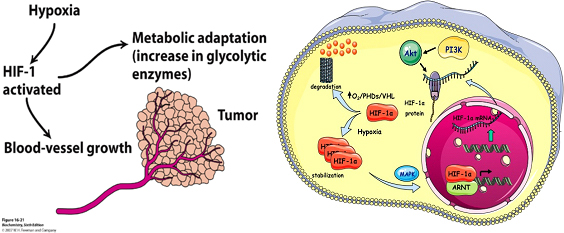
Research
, 2007

The faculty members of the Lab. of Biochemistry collaborate in a common research project entitled:
MOLECULAR MECHANISMS OF THE CELLULAR RESPONSE TO HYPOXIA: ACTIVATION AND FUNCTION OF THE HYPOXIA-INDUCIBLE TRANSCRIPTION FACTORS (HIFs) AND THEIR INVOLVEMENT IN CARCINOGENESIS.
The hypoxia-inducible transcription factors HIF-1 and HIF-2 are the key mediators of the cellular response to hypoxia (reduced oxygen concentration) which involves expression of many genes that promote anaerobic metabolism, erythropoiesis and angiogenesis. Hypoxia characterizes physiological processes, such as embryonic development and osteogenesis, as well as many pathological conditions such as ischemia and cancer. Regulation of HIFs has, therefore, extreme medical importance and is a validated therapeutic target.
More specifically, the following topics in connection to hypoxia are being currently investigated in the lab. Of biochemistry:
- The induction mechanisms of HIF-1α and HIF-2α by chemical and biological agents (DFO, cobalt, flavonoids) under normal or hypoxic conditions in human primary and cancer cell lines or tissues.
- The roles of HIF-1α and HIF-2α in cellular survival, proliferation and apoptosis of cancer cells.
- Regulation of HIF-1α by phosphorylation and nucleocytoplasmic transport in adenocarcinoma and hepatocarcinoma cells.
- Identification of proteins that interact with HIF-1α and the biological-medical significance of these interactions.
- Synthesis and application of molecularly imprinted polymers (MIPs) for the targeted isolation of bioactive natural compounds that modulate the HIF-1 signaling pathway and could be used in anticancer treatment.
- The role of hypoxia and HIFs in the expression and secretion of hepcidin, a new hepatic hormone that regulates iron homeostasis.
- The role of HIF-1α in the responsiveness and physiology of airway smooth muscle cells (in collaboration with the Lab. of Physiology).
- Development of specific antibodies for immunohistochemical analysis of HIF-1α expression in tumor samples (in collaboration with the Lab. of Pathology)
The faculty members of the lab are also involved independently in the following projects:
- Biogenesis, transport and aminoacylation of tRNA with emphasis on the structure and function of the Arc1p aminoacylation complex (G. Simos).
- The role of SR kinases in gene expression with emphasis on the interaction between SRPK1 and the nuclear matrix factors SAFB1/2 (E. Georgatsou).
- Oxidative stress and its role in endothelial function (P. Liakos).
- Application of chromatography/mass-spectroscopy in biomedical, clinical research and environmental toxicology research (A. Tsakalof).
Members of the Lab participate in the Institute of Biomedical Research and Technology (BIOMED) of the Center for Research and Technology, Thessaly
(CE.RE.TE.TH) as the “Biochemistry of Cellular Homeostasis” team led by Dr. G. Simos. In collaboration with other BIOMED teams the following are being investigated:
- Expression analysis of hypoxia target genes in biopsies from patients suffering from liver diseases in order to develop prognostic or diagnostic methods.
- Detection of simple nucleotide polymorphisms of the HIF-1α gene in patients in order to correlate them with disease states.